History and Traditions:
Looking Back as we Look Forward to 150
BY JESSICA BRAATZ

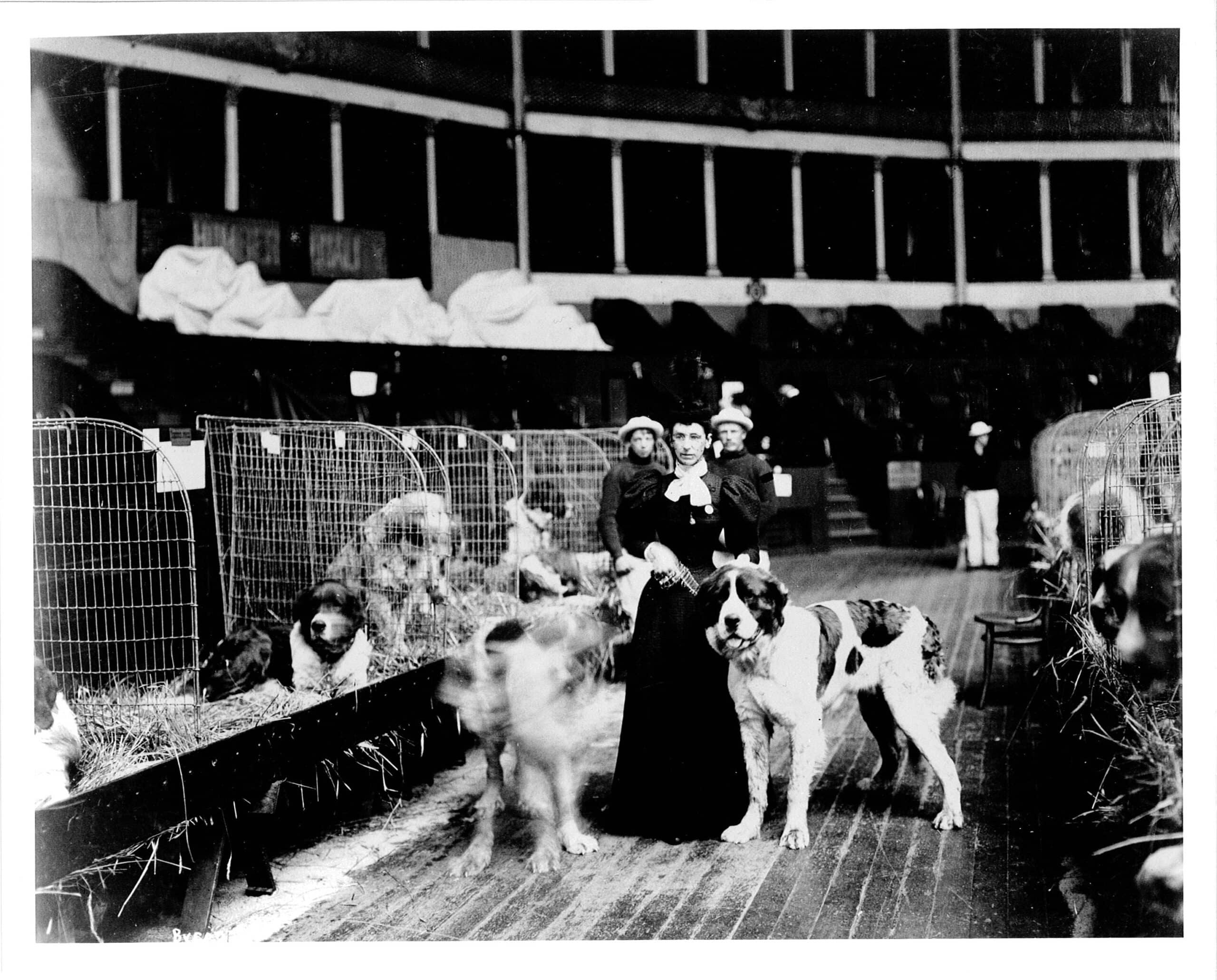
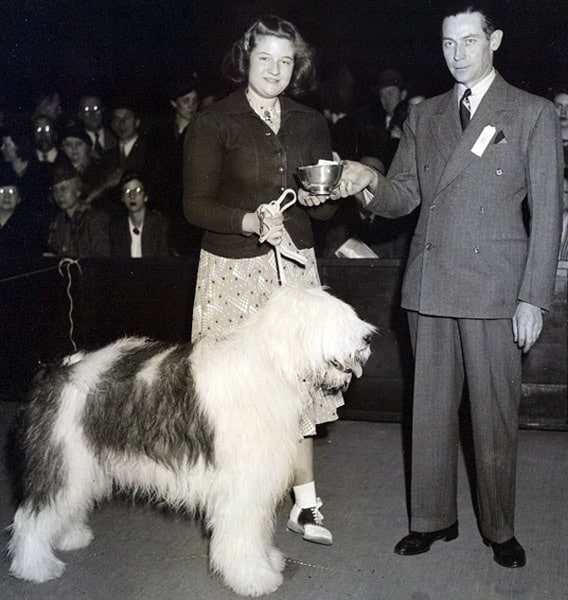
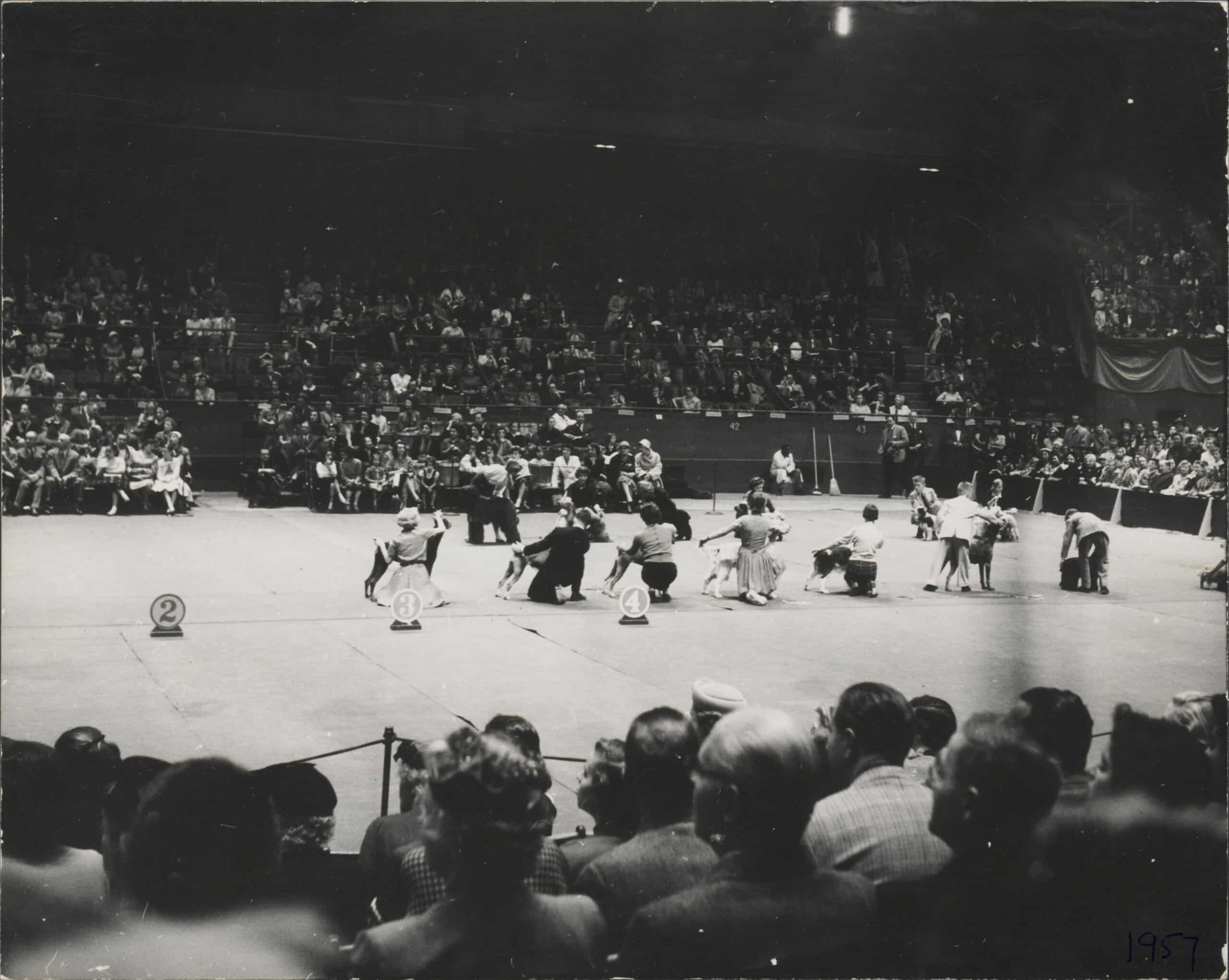
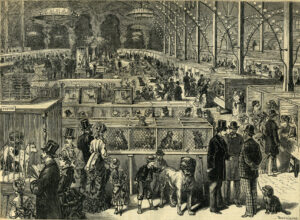
More than just a major event, Westminster is an annual celebration of canine excellence, grounded in the centuries of history, heritage, and tradition upon which the club was founded. Second only to the Kentucky Derby, the Westminster Kennel Club Dog Show is one of the oldest continuously held sporting events in America. And since its first show in 1877, Westminster has been drawing competitors and spectators from far and wide, with an astonishing 1,201 dogs entered in its first instance. Today, Westminster remains one of the most popular canine events globally, with an entry limit of 2,500 dogs that is consistently met year after year. Westminster’s success as an annual event can be attributed much to its prolific historical presence, with longtime fancier and judge Mr. Edd Bivin recounting in an interview, “It stands alone as being the American window into so much history in the sport of purebred dogs.” This legacy of excellence and innovation has evolved across generations and more than a century of shows, shaped by the steadfast resilience of the greatest American dog show. With the club’s 150th anniversary in 2026, we take this opportunity to step back and consider the traditions, history, and memories that make Westminster, Westminster.
The Show of all Shows
The first inklings of the club began in New York City, where a group of young gentlemen gathered at the Westminster Hotel to trade stories about their dogs. After noting the successes of shows in England and one in Philadelphia, they decided to host their own in New York, adopting the name of their meeting place as their kennel club title. Organized by The Westminster Kennel Club, the “First Annual New York Bench Show of Dogs” was a smashing success with its large entry and widespread media coverage. Thanks to a massive entry of 1,201 dogs, the club even had to extend the show an extra day to accommodate all of the exhibitors and spectators! The show was described by the newspaper Forest and Stream as a “magnificent triumph” with a record 20,000 spectators reported on the second and third days. With staggering success, the reign of the Westminster Kennel Club Dog Show had begun.
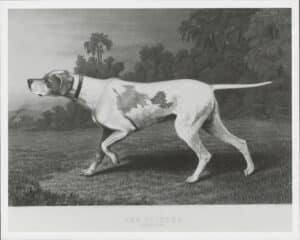 While the heart of the club remains the same now, the original Westminster Kennel Club had one key difference: dogs and kennels of their own. Originally located in Pascack, New Jersey, these kennels housed the club members’ shooting dogs, but more interestingly, they housed Pointers owned by the club itself. The first of these Pointers, “Sensation,” was a large lemon and white male dog of notable success. Whether or not you know this story, you’re probably already familiar with him, thanks to his important role within the club, even today. “Sensation” is the dog in the Westminster Kennel Club logo. And if you’ve attended the show in person, you’ve seen his image bedecking the walls, carpets, and ring gates, and maybe even visited his incredible, larger-than-life bronze statue that greets spectators upon entry.
While the heart of the club remains the same now, the original Westminster Kennel Club had one key difference: dogs and kennels of their own. Originally located in Pascack, New Jersey, these kennels housed the club members’ shooting dogs, but more interestingly, they housed Pointers owned by the club itself. The first of these Pointers, “Sensation,” was a large lemon and white male dog of notable success. Whether or not you know this story, you’re probably already familiar with him, thanks to his important role within the club, even today. “Sensation” is the dog in the Westminster Kennel Club logo. And if you’ve attended the show in person, you’ve seen his image bedecking the walls, carpets, and ring gates, and maybe even visited his incredible, larger-than-life bronze statue that greets spectators upon entry.
The original Westminster Kennel Club Dog Show differed from our competitions of modern times, mostly in terms of the show structure and breeds in competition. In its first instance, a mere 35 breeds competed, mostly those of hunting origin. Those of each breed competed against each other for a range of prizes, including gold necklaces and even a pearl-handled revolver. The show continued in this format until 1907, when the title of Best in Show was awarded for the first time. Unlike today, the honor was first awarded by a panel of ten judges who selected a Smooth Fox Terrier, “Ch. Warren Remedy,” as their winner. She would go on to win the next two consecutive years, claiming her place in the history books as the only dog to ever win Best in Show at Westminster three times.
1924 brought changes to the structure of the show, with Best in Show adhering to new American Kennel Club regulations. Before, where numerous dogs had competed for Best, these rules separated dogs into five Groups, and the winners of the newly anointed Sporting, Working, Terrier, Toy, and Non-Sporting Groups competed for the coveted title. In 1930, the Hound Group was added. And finally, the Herding Group was introduced in 1983, bringing Westminster much closer to the show we recognize today.
While the show navigated changes to regulations and four total versions of Madison Square Garden, it flourished in its resilience, becoming the largest dog show in history in 1905, with a total entry of 1,752, surpassing the last show held at the Crystal Palace in London. By 1908, the entry would reach 2,000 for the first time, and by 1937, the total number of dogs would surpass 3,000. In 1992, Westminster became the only champions-only dog show and remains this way today. More modernly, the entry has been limited to 2,500 dogs, ensuring the show functions smoothly in its current two-day conformation format.
Additionally, the show was a pioneer in entertainment and was televised for the first time in 1948. Extensive media coverage has remained a hallmark of Westminster ever since, with the show expanding to internet streaming in 2005. In its first year online, a record 1.4 million streaming videos were requested as viewers from 140 countries tuned in to expanded coverage of their beloved show.
Breaking Ground: A Vision for the Future
Since its founding, the club has focused its efforts broadly, reaching beyond convention and redefining tradition. In 1888, Anna Whitney made history as the first female to judge a dog show in America with her assignment of a whopping 117 Saint Bernards. In 1935, Mrs. Sherman Hoyt became the first female handler to claim the title of Best in Show with her Standard Poodle. And in 1956, Anne Hone Rogers became the first female professional handler to earn the same award.
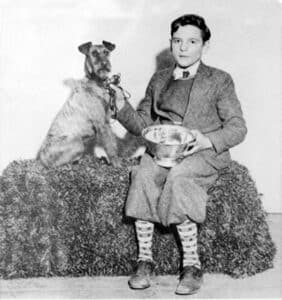 Westminster has also been steadfast in its support for the future of dog fanciers, first introducing the Children’s Handling Grand Challenge Trophy in 1934. This competition has evolved into what we modernly consider Junior Showmanship, an event that judges the skills of handlers between the ages of nine and 18. Averaging around 100 entrants annually, this Junior Showmanship competition is the pinnacle in America. Winners of the Best Junior Handler title have evolved to have careers as professional dog handlers, with many also becoming breeders and owner-handlers, as well, playing pivotal roles in the continuation of the sport. In addition to the title, the Junior Showmanship scholarship program was launched in 2010 and awards nearly $25,000 in scholarships annually.
Westminster has also been steadfast in its support for the future of dog fanciers, first introducing the Children’s Handling Grand Challenge Trophy in 1934. This competition has evolved into what we modernly consider Junior Showmanship, an event that judges the skills of handlers between the ages of nine and 18. Averaging around 100 entrants annually, this Junior Showmanship competition is the pinnacle in America. Winners of the Best Junior Handler title have evolved to have careers as professional dog handlers, with many also becoming breeders and owner-handlers, as well, playing pivotal roles in the continuation of the sport. In addition to the title, the Junior Showmanship scholarship program was launched in 2010 and awards nearly $25,000 in scholarships annually.
While efforts to preserve dog breeds and evaluate breeding stock represent the core ideology behind dog shows, The Westminster Kennel Club has maintained a strong commitment to philanthropy since its inception in 1876. After the extraordinary success of the inaugural show and the addition of a fourth day of events, the club donated the proceeds of the extra day to the American Society for the Prevention of Cruelty to Animals (ASPCA) to open a home for stray and disabled dogs. In 1918, the show’s proceeds were donated to the American Red Cross in support of the war effort. In 1919, this donation was repeated, and a special “service class” was offered for those who served in the Armed Forces. Later, in 1941 and 1942, proceeds were again donated to the American Red Cross. In 1943 and 1944, the donation shifted to Dogs for Defense and then to the National War Fund in 1945.
In 1982, The Westminster Kennel Club, alongside legendary dog enthusiast and judge Frank Sabella, became the first to donate art to the AKC Museum of the Dog, which now features an almost 2,000-piece collection and a 4,000-volume library. This collection of human-canine art showcases the deep bond between humans and their favored companions across centuries. In 1987, the Westminster Kennel Foundation established its annual scholarship program for veterinary students. As one of the oldest, mission-based organizations in the dog world, Westminster is dedicated to celebrating the companionship of dogs while promoting responsible dog ownership, health, and breed preservation. These listed contributions are just a drop in the bucket, with more history and impact to be found in our Westminster Cares Section.
And while The Westminster Kennel Club has made an immense historical and philanthropic impact, it has also deeply impacted the lives of the exhibitors, breeders, judges, and club members who participate in the show annually. When considering what Westminster means, Mr. Bivin further remarked that “we have a very dedicated community; it’s like a big family.” And those who have participated in the sport for decades or even for just a few years share the same sentiment. The Westminster Kennel Club is so special because of the community it has built historically and continues to build presently. It is special for the relationships it fosters, for the memories it cements forever, and for the traditions that last a lifetime.
Beyond the Books: Stories from Westminster Greats
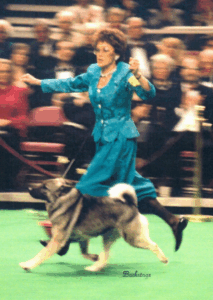 In light of the upcoming 150th anniversary of the Westminster Kennel Club Dog Show, we’ve asked some exhibitors, breeders, and judges about their own Westminster history. When asked to contribute to this piece, they all had a very similar sentiment—there are too many Westminster memories to narrow down to one. While our historical records and past contributions are central to the show’s success, the traditions and memories of those involved are equally meaningful, and we are honored to share these treasured stories.
In light of the upcoming 150th anniversary of the Westminster Kennel Club Dog Show, we’ve asked some exhibitors, breeders, and judges about their own Westminster history. When asked to contribute to this piece, they all had a very similar sentiment—there are too many Westminster memories to narrow down to one. While our historical records and past contributions are central to the show’s success, the traditions and memories of those involved are equally meaningful, and we are honored to share these treasured stories.
First is Westminster icon Pat Trotter, 2021 Best in Show judge and winner of an unprecedented 11 Hound Group firsts with her Vin-Melca Norwegian Elkhounds. One of her most treasured traditions was to “walk whatever Elkhound I was showing from the hotel near the Garden to Central Park. The dogs loved that experience.” Of her favorite memory, Pat said it was two-fold, “Winning our first group there in 1970 under judge Heywood Hartley, and the 11th one in 2017 judged by Polly Smith. Over those years, all the winners were related. All treasured memories indeed!”
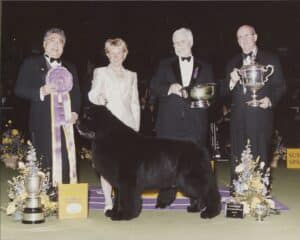 Next is Michelle Scott, a professional handler and lifelong dog enthusiast. She won back-to-back Best in Shows at the Westminster Dog Show in 2004 and 2005. This feat was notably accomplished with two different dogs, Newfoundland “Ch. Darbydale’s All Rise Pouch Cove” in 2004, and German Shorthaired Pointer “Ch. Kan-Point’s VJK Autumn Roses” in 2005.
Next is Michelle Scott, a professional handler and lifelong dog enthusiast. She won back-to-back Best in Shows at the Westminster Dog Show in 2004 and 2005. This feat was notably accomplished with two different dogs, Newfoundland “Ch. Darbydale’s All Rise Pouch Cove” in 2004, and German Shorthaired Pointer “Ch. Kan-Point’s VJK Autumn Roses” in 2005.
“A tradition that immediately comes to mind is the simple task of planning dinners at great restaurants with friends during the days leading up to the show. Sunday is always left for Michael and me to have a quiet early dinner at the bar of a restaurant we love to prepare for the busy two days ahead. Still focused on food, Michael reminded me of finding our way to Sbarro for a bowl of pasta to take back to the room and enjoy in bed late at night after the awards dinner! It always tasted so good after a fancy evening.”
Michael Scott’s tradition was a little simpler. While he may indulge in some late-night pasta with his wife, Michelle, his own tradition is to ensure he has a tuxedo to wear when showing in the group or, “most definitely in Best.” With his many group wins throughout his time competing at Westminster, it’s tradition that he always has one with him.
As the winner of 2023’s Best in Show with Petit Basset Griffon Vendéen “Buddy Holly,” Janice Hayes had too many Westminster memories to pare down, but said that “winning Best in Show takes the cake!” On that extraordinary day, Janice lived and breathed Westminster, as the first handler in the ring at 8 a.m. and the last to leave once everyone cleared out, massive purple and gold ribbon in tow. Her annual tradition is “to get in the city a few days early and get the dogs acclimated to the atmosphere. It is always amazing to me how well the dogs adapt to the situations we put them in. Every time they step out on the carpet for the first time, they rise to the occasion! It never gets old!”
Octavia Stensen was awarded Best Junior Handler in 2024. As an assistant to a professional handler, she is busy when she visits the city, but she “always makes time for a classic New York bagel or a slice of pizza, usually the day before or the day of the show. Enjoying a bit of that iconic NYC flavor has become a small but special tradition for me!”
Jennifer Crank is a world champion Agility handler who made Westminster history in 2020, when her Border Collie, “P!nk,” became the first non-20″ dog to be crowned the Masters Agility Champion. Her annual tradition is “to bring out all my purple and gold swag, both for the dogs AND me! All the dogs have their own custom WKC leashes with purple and gold rhinestones that only get used at this single event each year. I look forward to the packing of unique, fun, and extravagant items we get to use at this prestigious event.”
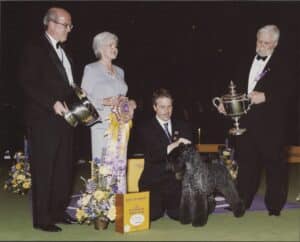 Bill McFadden is no stranger to the city, as the winner of Best in Show in both 2003 and 2018. Yet, his annual tradition is “to walk in the city—rain, snow, or shine—often with a dog, weather permitting.” His favorite Westminster memory happened while walking “Mick,” the Kerry Blue Terrier who claimed the Best in Show title in 2003. During their walk, “blue collar guys up on the scaffolding yelled down asking if that was Mick! This was during the heyday of Animal Planet televising a few shows a year, so the public seemed to be very aware of the ‘players.’ It was so cool for the sport to have that connection with the public, and I’ll never forget it.”
Bill McFadden is no stranger to the city, as the winner of Best in Show in both 2003 and 2018. Yet, his annual tradition is “to walk in the city—rain, snow, or shine—often with a dog, weather permitting.” His favorite Westminster memory happened while walking “Mick,” the Kerry Blue Terrier who claimed the Best in Show title in 2003. During their walk, “blue collar guys up on the scaffolding yelled down asking if that was Mick! This was during the heyday of Animal Planet televising a few shows a year, so the public seemed to be very aware of the ‘players.’ It was so cool for the sport to have that connection with the public, and I’ll never forget it.”
For more history, check out these links, and look out for more historically-focused posts as we approach the sesquicentennial show in 2026!
https://www.westminsterkennelclub.org/conformation-records/
https://www.westminsterkennelclub.org/sensation-and-the-wkc-logo/

